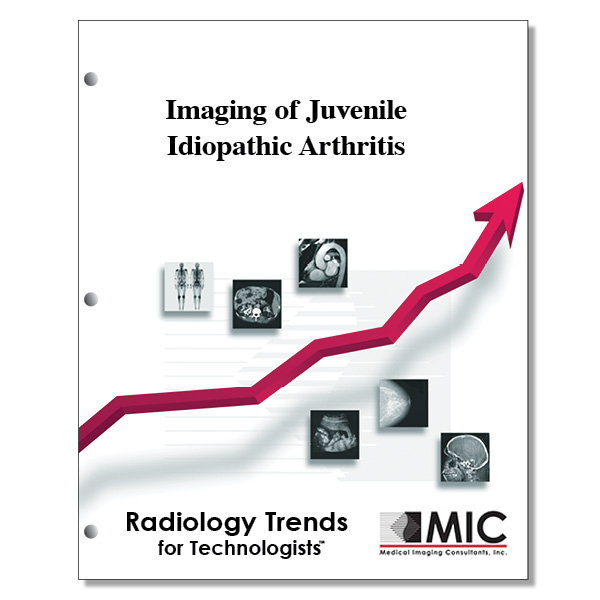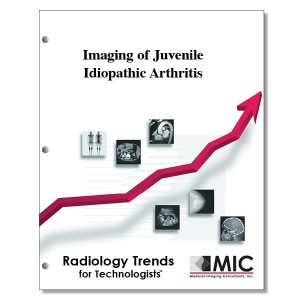

Imaging of Juvenile Idiopathic Arthritis
A review of the most recent classification system for JIA along with current imaging approaches for peripheral joints and complex structures.
Course ID: Q00386 Category: Radiology Trends for Technologists Modalities: MRI, Radiography, Sonography4.0 |
Satisfaction Guarantee |
$39.00
- Targeted CE
- Outline
- Objectives
Targeted CE per ARRT’s Discipline, Category, and Subcategory classification:
[Note: Discipline-specific Targeted CE credits may be less than the total Category A credits approved for this course.]
Magnetic Resonance Imaging: 2.00
Procedures: 2.00
Musculoskeletal: 2.00
Radiography: 2.00
Procedures: 2.00
Extremity Procedures: 2.00
Registered Radiologist Assistant: 4.00
Procedures: 4.00
Musculoskeletal and Endocrine Sections: 4.00
Sonography: 2.00
Procedures: 2.00
Superficial Structures and Other Sonographic Procedures: 2.00
Outline
- Introduction
- JIA Classification
- Imaging Evaluation
- Radiography
- MR Imaging
- Ultrasonography
- Joint-specific Findings and Recommendations
- Peripheral Joints
- Cervical Spine
- Temporomandibular Joints
- Sacroiliac Joints
- Conclusion
Objectives
Upon completion of this course, students will:
- be familiar with the criteria that defines juvenile idiopathic arthritis (JIA)
- identify which medical imaging modalities play a role in diagnosing JIA
- know the various subtypes of JIA and which one is the most common
- understand the clinical features of each type of JIA
- understand the serologic lab findings that are part of testing for JIA
- know which sub type of JIA can potentially be fatal
- be able to define the term enthesitis
- know which tendon is most commonly affected in patients with ERA
- be familiar with the seven ILAR classifications of JIA
- now what dactylitis is
- understand the principles of ALARA
- know the radiographic signs and findings of JIA in late stages of disease
- understand the composition of the pediatric skeleton and the limitation of obtaining radiographic detection of early erosive changes in children
- be able to explain radiographic signs and findings of JIA in early stages of disease
- be able to define orthoroentgenography
- understand which sub type of JIA has more of a prevalence of erosion and joint space loss
- understand the role of weight-bearing radiography
- understand which inflammatory states and conditions are common with JIA
- be able to explain the radiographic views for performing cervical spine radiography on patients with JIA
- be able to define the term pannus
- know which joints are commonly affected by JIA
- be able to explain the radiographic views for performing knee radiography on patients with JIA
- be familiar with which medical imaging modality is the most sensitive for detecting synovitis in patients with JIA
- know which medical imaging modality can detect bone marrow edema in patients with JIA
- be able to describe the semi quantitative scoring system and imaging protocol for the assessment of synovitis, bone marrow edema, and bone erosions created by OMERACT
- understand how MR is used to assess the bone marrow and erosions in patients with JIA
- understand the use of T2 relaxation time cartilage mapping for evaluating patients with JIA
- be able to describe the sonographic appearance of normal cartilage
- know the frequencies of transducers used for musculoskeletal US on patients with JIA
- know which medical imaging modality is more sensitive for detecting joint effusions and synovial thickening
- be familiar with standard US nomenclature
- understand the uses of color and power Doppler US
- understand what benefits color and power Doppler US offer in imaging inflammation in patients with JIA
- be able to describe common US artifacts such as anisotropy
- know the MR imaging definitions of joint and soft tissue disease in patients with inflammatory arthritis
- understand the term rice bodies
- know which medical imaging modality can visualize bone marrow edema on patients with JIA
- understand the characteristic radiographic findings in the cervical spine of patients with JIA
- know the role of each medical imaging modality in evaluating the TMJs in patients with JIA
- be familiar with the imaging protocols and radiographic positions used when evaluating the TMJs
